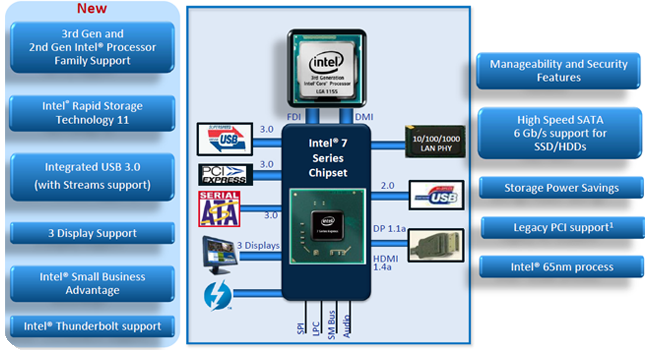Meet the chipsets...
In a somewhat strange turn of events, Intel decided to launch its seven-series chipsets prior to the arrival of its accompanying Ivy Bridge processors. What you see on this page should therefore act as a refresher, but you can get further detail in our review of a seven-series Gigabyte motherboard; the Z77-D3H.

Looking at the chipset overview, we can see that seven-series boards will offer a couple of key upgrades, including native USB 3.0 integration (a first for Intel), 16 PCIe lanes from the CPU that adhere to the high-speed PCIe 3.0 specification, and the ability to drive three independent displays direct from the IGP.
Whether or not these upgrades matter to you will depend on your own personal usage scenarios, but here's an overview of what's on offer from the three new consumer seven-series boards, compared with some of the last-generation alternatives:
Intel Chipset Comparison |
||||||
|---|---|---|---|---|---|---|
| Chipset | Z77 |
Z75 |
H77 |
Z68 |
P67 |
H67 |
| Processor Socket | LGA1155 |
LGA1155 |
LGA1155 |
LGA1155 |
LGA1155 |
LGA1155 |
| CPU Interface | DMI |
DMI |
DMI |
DMI |
DMI |
DMI |
| CPU Overclocking Support | Yes |
Yes |
No |
Yes |
Yes |
No |
| IGP Enabled | Yes |
Yes |
Yes |
Yes |
No |
Yes |
| Independent Display Support | 3 |
3 |
3 |
2 |
2 |
2 |
| CPU PCIe Configurations | 1 x16 PCIe 3.0 |
1 x16 PCIe 3.0 |
1 x16 PCIe 3.0 |
1 x16 PCIe 2.0 |
1 x16 PCIe 2.0 |
1 x16 PCIe 2.0 |
or |
||||||
2 x8 PCIe 3.0 |
2 x8 PCIe 3.0 |
x |
2 x8 PCIe 2.0 |
2 x8 PCIe 2.0 |
x |
|
or |
||||||
1 x8 + 2 x4 PCIe 3.0 |
x |
x |
x |
x |
x |
|
| Chipset PCIe Lanes | 8 PCIe 2.0 |
8 PCIe 2.0 |
8 PCIe 2.0 |
8 PCIe 2.0 |
8 PCIe 2.0 |
8 PCIe 2.0 |
| Memory Channels | Dual |
Dual |
Dual |
Dual |
Dual |
Dual |
| Memory Support | DDR3 1,600 |
DDR3 1,600 |
DDR3 1,600 |
DDR3 1,333 |
DDR3 1,333 |
DDR3 1,333 |
| Native USB 3.0 Ports | 4 |
4 |
4 |
0 |
0 |
0 |
| Native USB 2.0 Ports | 10 |
10 |
10 |
14 |
14 |
14 |
| SATA 6Gbps Ports | 2 |
2 |
2 |
2 |
2 |
2 |
| SATA 3Gbps Ports | 4 |
4 |
4 |
4 |
4 |
4 |
| Smart Response Technology | Yes |
No |
Yes |
Yes |
No |
No |
In keeping with Ivy Bridge processors, we can see that Intel has also streamlined the companion chipsets. Unlike Sandy Bridge, which arrived with one chipset that supported integrated graphics (H67) and another that didn't (P67), Intel has this time ensured that all three consumer-orientated seven-series chipsets feature IGP support as standard.
Backward and forward compatibility
We've become so accustomed to Intel introducing new sockets on a whim that it's worth reiterating that the six- and seven-series chipsets are compatible in both directions. There's no real harm in slotting an Ivy Bridge processor into a six-series board (provided the vendor has issued requisite BIOS and driver updates) and there's nothing stopping you from using a Sandy Bridge chip in a seven-series board (though, you would of course forego certain Ivy Bridge-specific features).
Nice to know, but the arrival of Z77, Z75 and H77 has made Z68, P67 and H67 look largely redundant, and a seven-series board coupled with an Ivy Bridge processor is clearly the optimum combination.









